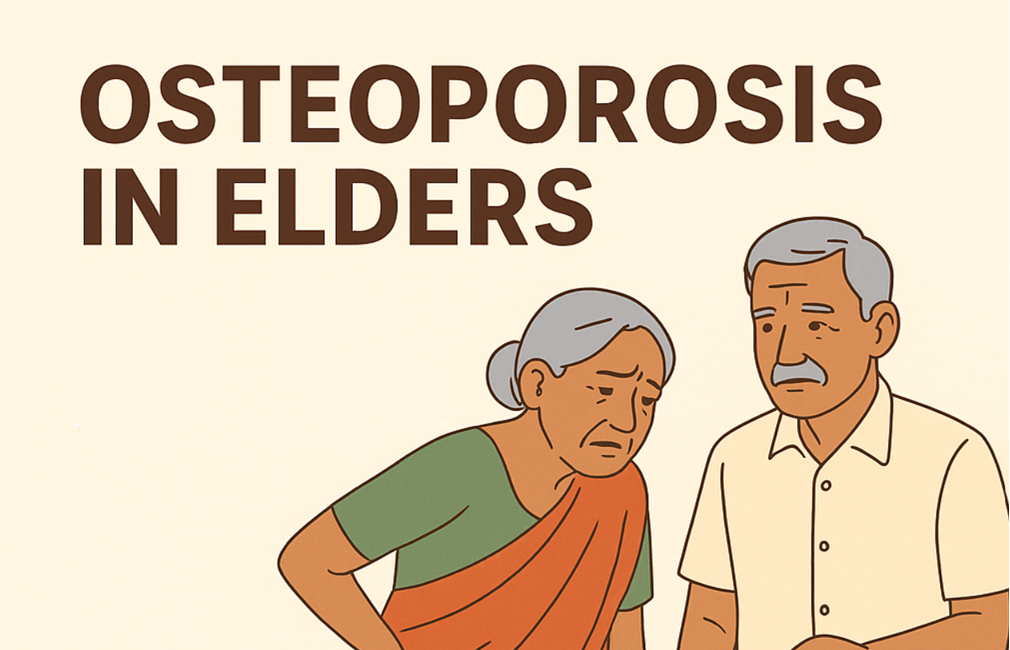Introduction
Osteoporosis is one of the most common age-related bone diseases in senior citizens. It causes bones to become weak, brittle, and more likely to fracture—even from a small fall or simple activities like bending or lifting. Although osteoporosis is more common in women after menopause, it also affects older men.
The good news: Early management, the right diet, and lifestyle changes can slow, stop, or even partially reverse bone loss.
What is Osteoporosis?
Osteoporosis occurs when the body loses too much bone or does not produce enough new bone.
With age, bone tissues naturally thin, but in osteoporosis, this process accelerates, causing bones to become porous like a honeycomb.
Common Symptoms
Often, osteoporosis shows no symptoms until a fracture occurs. However, elders may notice:
- Back pain
- Loss of height over time
- Stooped posture
- Fragile bones that break easily
- Hip, wrist, or spine fractures
Major Causes in Elders
- Aging (natural bone loss)
- Calcium & Vitamin D deficiency
- Menopause / low estrogen (women)
- Low testosterone (men)
- Lack of physical activity
- Poor diet
- Long-term steroid use
- Smoking & alcohol
- Genetic factors
Diet for Osteoporosis: What Elders Should Eat
Diet plays a crucial role in maintaining bone density. Here is what to include:
1. Calcium-Rich Foods
Calcium is the main building block of bones.
Best Indian Sources
- Milk, curd, paneer
- Ragi (finger millet)
- Sesame seeds (til)
- Almonds
- Green leafy vegetables (spinach, methi)
- Soy milk / tofu
- Sardines, salmon (if non-vegetarian)
Daily requirement for elders:
1,200 mg/day (ask doctor for exact needs)
2. Vitamin D
Helps the body absorb calcium.
Sources
- Morning sunlight (15–20 mins)
- Egg yolks
- Fortified milk
- Mushrooms
- Supplements if needed (usually doctor-prescribed)
3. Magnesium & Zinc
Important minerals for bone strength.
Sources
- Nuts (almonds, cashews)
- Whole grains (brown rice, oats)
- Pumpkin seeds
- Beans and lentils
4. Protein
Supports bone and muscle strength.
Sources
- Eggs
- Milk, curd, paneer
- Lentils (dal), chana, rajma
- Fish & lean meat
5. Foods to Avoid
- Excess salt (increases calcium loss)
- Too much caffeine (more than 2–3 cups tea/coffee)
- Carbonated soft drinks
- Smoking & alcohol
- Deep-fried and junk food
How to Overcome Osteoporosis
1. Regular Weight-Bearing Exercises
These exercises help rebuild bone:
- Walking 30 minutes/day
- Climbing stairs
- Tai Chi
- Yoga (especially Vrikshasana, Tadasana)
- Strength training with light weights
Always start slowly and consult a physiotherapist if needed.
2. Sunlight Exposure
15–20 minutes of early morning sunlight improves Vitamin D levels, which is essential for absorbing calcium.
3. Adequate Calcium & Vitamin D Supplements
Doctors often prescribe:
- Calcium tablets
- Vitamin D3 weekly/monthly sachets
- Osteoporosis medications (bisphosphonates, etc.)
Do not self-medicate. Take only under medical guidance.
4. Fall Prevention
Since fractures are the biggest danger:
- Use anti-slip mats
- Keep home well-lit
- Remove clutter
- Wear supportive footwear
- Use walking sticks if balance is poor
5. Regular Health Check-ups
Recommended tests:
- Bone Mineral Density Test (DEXA scan)
- Calcium & Vitamin D levels
- Thyroid tests
This helps track bone loss and adjust treatment early.
Conclusion
Osteoporosis is common in elders, but it is manageable and preventable with the right diet, exercise, sunlight, supplements, and lifestyle changes. With early detection and consistent care, seniors can maintain strong bones and continue to live an active, independent life.


